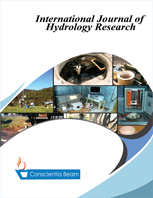Estimation of Ground Water Recharge for Irrigation Water Budget Planning in Kanzenze Swamp
DOI:
https://doi.org/10.18488/journal.108.2020.51.46.53Abstract
Groundwater is the dynamic local water source for agriculture, industry, wildlife and human development activity. Hence, in order to sustain long-term groundwater use, make intelligent groundwater allocation decisions and water budget planning, develop on-farm water management strategies, the estimation of the net groundwater recharge from agricultural areas like Kanzenze swamp is paramount important. The study findings therefore showed that Ground Water Recharge estimation for the study area ranges from 33.85mm to 52.96mm while the average mean of ground water recharge is about 45.06mm per year. The coefficient of ground water recharge is ranging from 3.41% to 5.27% while average mean recharge coefficient is 4.06% recharged to ground water level yearly. However, monthly basis planning have advantages for farmers’ water budgeting. It revealed that highest recharge coefficient is recorded in months of March, April and November representing 17.22% and 17% of the mean monthly rainfall while the lowest recharge coefficient is recorded during the period of June, July and February representing 16.17%, 15.73% and 16.71% of the average monthly rainfall. Thus, it is recommended that utmost farmers around the Kanzenze swamp should plan the irrigation activities and minimizes unnecessary water use consumption in such way that in June and July there is water enough water even taught there is shortage of rainfall. It meant that priori irrigation systems should be applied to obtain optimum moisture content and water table levels for effective crop production mainly horticultural crops in season C rather than season A and season B of cultivation in Rwanda.

